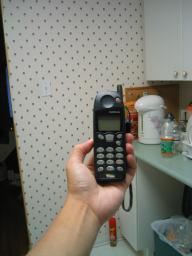Looking back to all the phones I got over the past 10 years, realized just how the industry has changed and the impact on my lifestyle. It's a personal journey of technological discovery.
Back in '99 when I first become a Fido customer, my first phone was a Nokia 5190. It's a 1900Mhz GSM phone. GSM is the first global digital cellular wireless standard. In North America, the industry was moving from AMPS (analog) to IS136 TDMA (dgital) under the PCS push. However, some of the green field deployment went to GSM instead. The move to digital helps carriers improve spectrum efficiency (means more users/channel), also better voice quality (via EVRC) and battery life for users. I picked Fido/GSM even through I work for Nortel's TDMA team at the time generally because I believed it's the future; Afterall, most of the world adapt the standard, there are more cool phones and supposedly I can roam seamlessly worldwide (even it will cost me $$$$). Also, the pricing from Fido was just cheaper.
The next few years there after, I changed to a Nokia 3390 and Sony /// T200. The main reason I upgraded was that a friend works at a phone store that he can get me a great discount, plus some improvement on the device; smaller size, hidden antenna, better ringtone, T9 text input for SMS, and worldphone (as for T200).
When I got Sony/// z600 in 2005, there is for some exciting new reasons; camera, bluetooth, and MMS. In addition, z600 has a clamshell form factor, a good japan-ish design that rarely seem in phone here in N.A. Also, many friends of my finally got a cellphone, so we call and SMS each other more. Meanwhile, carriers start to push for MMS and better priced SMS plan. A $3/100 SMS plan become one of the most used features on my Fido plan. In addition, the camera on the z600, in a way, getting me started to use my phone more than just a communication device. I enjoy the freedom to take snapshoots, keep track of things with todo list, calendar, and note. This fuel for a desire to upgrade to my next phone - Moto Ming.
I was on a business trip to Guangzhou, China in Q2/Q3 of 2006, Moto Ming smartphone was just released in Hong Kong at the time, where I travel to often over weekends to visit friends and families (it's only a 2 hours train ride). I was instantly attract to it; a cool design in small form factor, music/video player, touch-screen, Chinese hand-writing input, improved camera, GPRS/EDGE data, Java, and PDA functions. The phone becomes an essential part of my life; listen to podcast, take snap-shoots on the street, keep track of bits and pieces of information. These functions roll into one device with my voice and SMS needs, while it still fit into my pants pocket.
Since last year, Fido introduced a $5/500Kb plan. In general, it's a joke. I start Google maps, and it uses over 300Kb just to load one map. But fortunately, this sad fact changed after I moved to San Francisco; T-mobile's $20/unlimited GPRS/EDGE Total Internet plan is just the plan I needed. Google maps becomes the most important tools on my Ming, especially when I am lost somewhere; I can get up-to-date tweets on MUNI. It's not very fast, but able to provide what I need reasonably.
But, I really need is a device that has a bigger pipe, larger screen that allow me to connect and stay in contact. UMTS has been out for many years, but never catch on here in N.A. Its evolution, HSPA, is finally makes a début as a response to popular 3.5G 1xEvD0 data service from Verizon/Sprint. I am almost seeing it - Hyperconnectivity. A must-have list of required features for my next cellphone: 3.5G, GPS, WIFI, and bigger screen.
Anyway, I think this post is really getting too long, I am going to continue in the next post.

 My passion has always been on software development, and I know it since I
wrote my first program on an Apple II. I worked on cellular wireless system
in the past (C/C++) and now focus on web application
(LAMP, PHP, MySQL, CakePHP, Symfony, jQuery, Google AppEngine/python).
My passion has always been on software development, and I know it since I
wrote my first program on an Apple II. I worked on cellular wireless system
in the past (C/C++) and now focus on web application
(LAMP, PHP, MySQL, CakePHP, Symfony, jQuery, Google AppEngine/python).
![[Valid XHTML 1.0 Strict]](https://edmondhui.ddns.net/blog/skins/admun3/valid-xhtml.png)
Comments
Leave comment
Trackback